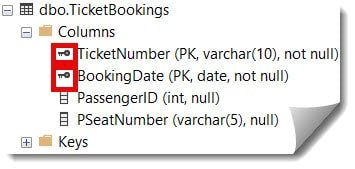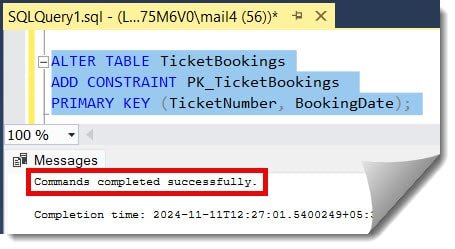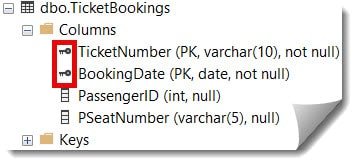Recently, my team was required to create tables with multiple primary keys in SQL Server. We analyzed the requirement and identified a few simple approaches to achieve this. In this article, I will walk you through multiple ways to do this task. Remember that this is known as Composite Primary Key.
SQL Server Create Table 2 Primary Key
Before starting, let me try to give a basic idea of what a composite primary key is.
What is a Composite Primary Key?
It is a unique identity for a table that consists of two or more columns. This is required when a single column cannot uniquely identify a record.
Approach 1: Using the CREATE TABLE Query
Using the query below, we can mention the two columns we want to create during the table creation process.
Example
In the below example, we are creating a TicketBookings table with two primary keys: TicketNumber and BookingDate. Let us execute the SQL query below.
CREATE TABLE TicketBookings (
TicketNumber VARCHAR(10),
BookingDate DATE,
PassengerID INT,
PSeatNumber VARCHAR(5),
CONSTRAINT PK_TicketBookings PRIMARY KEY (TicketNumber, BookingDate)
);The command was completed successfully, as shown in the screenshot below.

Check out the screenshot below; the two primary keys were created successfully.

Approach 2: First, create the table and then alter the composite primary key
In this approach, we need to create the table first, and then we can update the composite primary key to the newly created table.
Example
In the following example, we create a new table, TicketBookings, with the query below.
CREATE TABLE TicketBookings (
TicketNumber VARCHAR(10) not null,
BookingDate DATE not null,
PassengerID INT,
PSeatNumber VARCHAR(5)
);The table was created successfully after executing the above query, as shown in the screenshot below.

With the query below, let us alter the newly created table with the two primary keys, TicketNumber and BookingDate.
ALTER TABLE TicketBookings
ADD CONSTRAINT PK_TicketBookings
PRIMARY KEY (TicketNumber, BookingDate);After executing the above query, the command executed successfully, and the composite primary key was created successfully, as shown in the screenshot below.


Check out Cannot Define Primary Key Constraint On Nullable Column In Table in case you get any error after executing the above query.
FAQs
Can a table have two primary keys in SQL
Answer: Yes, you can create a composite primary key for multiple columns.
Conclusion
Using any of the approaches mentioned in this article, creating tables with composite primary keys in SQL Server is easy. Now, you choose the best strategy based on your requirements.
You may also like following the articles below.
- Create table if not exists SQL Server
- How To Create A Table Variable In SQL Server
- How To Create A Temp Table In SQL Server
- How To Create A Table With Identity Column In SQL Server

Grey is a highly experienced and certified database expert with over 15 years of hands-on experience in designing, implementing, and managing complex database systems. Currently employed at WEX, USA, Grey has established a reputation as a go-to resource for all things related to database management, particularly in Microsoft SQL Server and Oracle environments. He is a Certified Microsoft SQL Server Professional (MCSE: Data Management and Analytics) and Oracle Certified Professional (OCP), with Extensive database performance tuning and optimization knowledge and a proven track record in designing and implementing high-availability database solutions.